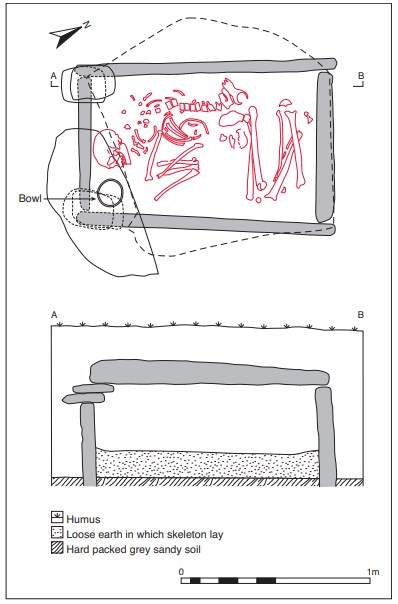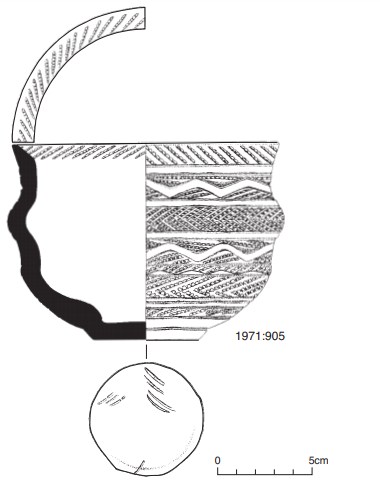County: Westmeath Site name: MILLTOWN, CO. WESTMEATH
Sites and Monuments Record No.: SMR WM025-049 Licence number: E1173
Author: JOSEPH RAFTERY
Site type: Early Bronze Age graves
Period/Dating: —
ITM: E 723306m, N 724935m
Latitude, Longitude (decimal degrees): 53.260421, -6.151799
Introduction
In early February 1971 a short cist containing an inhumation and a bowl was discovered during ploughing operations on a farm near Castletown Geoghegan, Co. Westmeath. The capstone of the cist had been discovered about 0.2m below ground level when the point of the plough caught in it and moved it approximately 0.4m out of position so that the southern corner was exposed. The vessel was removed from the grave but the area was otherwise left undisturbed. The site was reported to the NMI by Mrs Ruth Vandeleur, Wardenstown, Co. Westmeath.


A one-day rescue excavation was undertaken by Dr Joseph Raftery. The human remains from the cist were examined by Professor C.A. Erskine.
Location (Fig. 3.191)
The site was in the townland of Milltown, just 4km north of Castletown Geoghegan, mid-Co. Westmeath.333 It was situated on a slight elevation at an altitude of 110–120m above sea level. No sites of similar date are known from this townland.
Description of site
The cist was rectangular in plan, with its long axis running north-east/south-west. Internally it measured 1.18m long by 0.8m wide by 0.48m high (Fig. 3.192). It was constructed of four thin edge-set slabs, with a maximum thickness of 0.1m. Each of the four slabs formed a wall of the cist. That at the south-western end was somewhat shorter than the others, and this was compensated for by positioning smaller stones on the end stone in order that the capstone would rest level on all four walls. All of the cist slabs were of limestone. There was no evidence for packing stones around the outside of the cist. A large, subrectangular capstone measuring 1.28m long by 1.24m wide by 0.12m thick sealed the cist. The floor of the cist was not paved but was formed of hard, grey, packed soil.
The grave contained a crouched inhumation burial of a male (1971:906) and a tripartite bowl. The cist was filled to a depth of about 0.15m with loose earth, which had apparently been thrown in to partly cover the body. The body lay on its right side, with the arms and legs flexed and the head at the south-western end and the feet at the north-east. The bowl had been placed close to the skull in the south-eastern corner. According to Raftery, the hands had been placed at either side of the vessel.
Tripartite bowl, 1971:905 (Fig. 3.193)
The ware is buff in colour, rather coarse, with many pebble grits occurring. The outer surface appears to be slipped. The rim is internally bevelled and slightly everted. The base is flat. The internal bevel of the rim is decorated with close-set oblique, comb-impressed strokes. The body of the vessel is heavily decorated: the ornament is zoned in horizontal bands and will be described in order from the rim to the base. Immediately below the rim is a band of oblique strokes with comb impressions. This is bordered at its lower edge by a false-relief plain ridge. This is followed by a continuous chevron line, also in false relief, with the background filled in with oblique comb-impressed lines. The lower edge of this motif is defined by a plain falserelief ridge. There follows a broad band of chevron formed of comb impressions. The lower edge of this motif is again marked by a false-relief ridge.

This ridge and another lower one decorated with oblique cog-impressed strokes define a continuous zigzag line with infilled background similar to that described above. A further broad chevron pattern similar to that described above follows. The lower edge of this motif is demarcated by two plain and one decorated (with oblique comb-impressed strokes) false-relief ridges. Finally, there is a further undecorated ridge in false relief. Although casual strokes occur on the base, it is undecorated.
Dimensions: H 10.5cm; ext. D rim 14.2cm; D base 6cm; T rim 0.6cm.
Comment
A radiocarbon determination from a collagen sample produced a date of 3755±35 BP,334 which calibrates to 2287–2038 BC at 95% probability. Brindley (2007, 246–7) places this vessel in stage 2 of the development of the bowl tradition, and suggests that this took place over a period of 100 years centred on 2030 BC (i.e. 2080–1980 BC).
HUMAN REMAINS
C.A. ERSKINE
Nearly complete skeleton (1971:906) in very good state of preservation. Male characters (innominate bone, sacrum). Stature 5ft 10–11in. [1.78m]; aged about 25 years.
Skull: very well marked and complete cranial vault sutures, with metopic suture. Brachicephalic. Slight asymmetry, probably post-mortem. Complete dentition maxilla and mandible. Moderate wear, slight in third molars. Perfect mandible with well-marked muscle markings.
Vertebrae: very well preserved (one cervical missing). No peculiarities.
Ribs: some fragmentation and incomplete.
Sternum: manubrium and parts of body only present.
Pelvis: incomplete, parts of innominate bones missing, especially on left side.
Sacrum shows fusion of a lumbar vertebra with the sacrum (sacralisation), although there are five lumbar vertebrae present.
Arm bones: well preserved, including clavicles. Only peculiarity is disproportion in lengths of radius and ulna with humerus. Radius and ulna are 1–2cm longer than would be expected.
Leg bones: well preserved. Erosion in one fibula and irregularities in shafts of both. It is concluded that neither of these changes is pathological.
333. Parish of Churchtown, barony of Rathconrath. SMR WM025-049——. IGR 23383 24907.
334. GrN-11903.